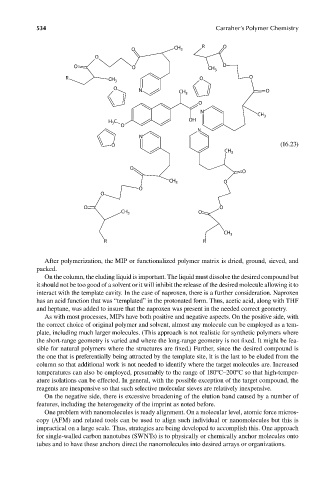Page 571 - Carrahers_Polymer_Chemistry,_Eighth_Edition
P. 571
534 Carraher’s Polymer Chemistry
R O
O CH 3
O
O O CH 3 O
R CH 3 O O
O N CH 3 O
O
N
CH 3
H C – OH
3
O
N
N
O (16.23)
CH 3
O
O
CH 3 O
O
O
O O
O
CH 3
CH 3
R R
After polymerization, the MIP or functionalized polymer matrix is dried, ground, sieved, and
packed.
On the column, the eluding liquid is important. The liquid must dissolve the desired compound but
it should not be too good of a solvent or it will inhibit the release of the desired molecule allowing it to
interact with the template cavity. In the case of naproxen, there is a further consideration. Naproxen
has an acid function that was “templated” in the protonated form. Thus, acetic acid, along with THF
and heptane, was added to insure that the naproxen was present in the needed correct geometry.
As with most processes, MIPs have both positive and negative aspects. On the positive side, with
the correct choice of original polymer and solvent, almost any molecule can be employed as a tem-
plate, including much larger molecules. (This approach is not realistic for synthetic polymers where
the short-range geometry is varied and where the long-range geometry is not fixed. It might be fea-
sible for natural polymers where the structures are fixed.) Further, since the desired compound is
the one that is preferentially being attracted by the template site, it is the last to be eluded from the
column so that additional work is not needed to identify where the target molecules are. Increased
temperatures can also be employed, presumably to the range of 180ºC–200ºC so that high-temper-
ature isolations can be effected. In general, with the possible exception of the target compound, the
reagents are inexpensive so that such selective molecular sieves are relatively inexpensive.
On the negative side, there is excessive broadening of the elution band caused by a number of
features, including the heterogeneity of the imprint as noted before.
One problem with nanomolecules is ready alignment. On a molecular level, atomic force micros-
copy (AFM) and related tools can be used to align such individual or nanomolecules but this is
impractical on a large scale. Thus, strategies are being developed to accomplish this. One approach
for single-walled carbon nanotubes (SWNTs) is to physically or chemically anchor molecules onto
tubes and to have these anchors direct the nanomolecules into desired arrays or organizations.
9/14/2010 3:43:08 PM
K10478.indb 534 9/14/2010 3:43:08 PM
K10478.indb 534

